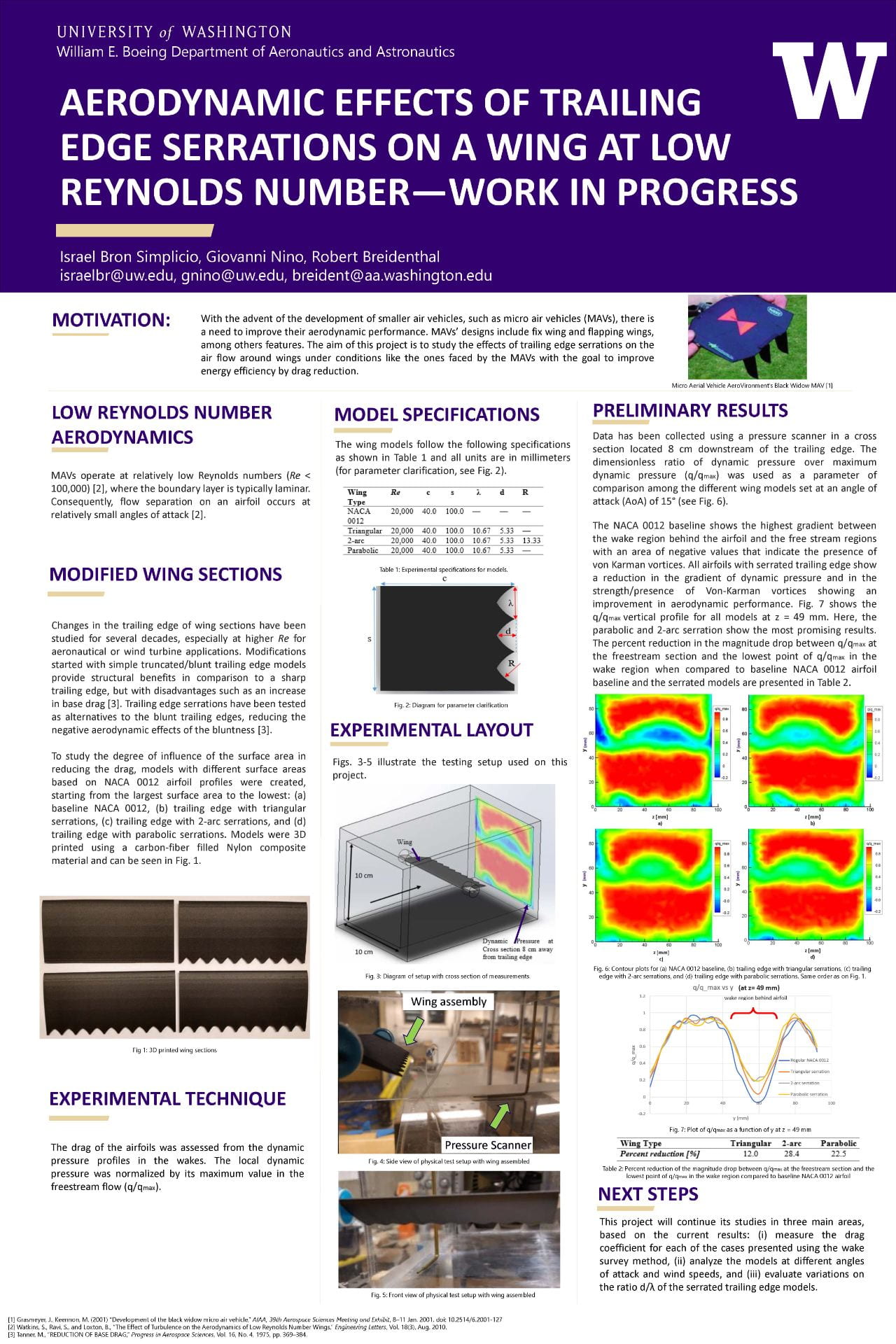Vortex Whip
The concept of a “vortex whip” refers to an idea to improve the performance of vortex generators in inhibiting boundary layer separation. Since the boundary layer is a layer where frictional effects are significant, if we can reduce the extent of the boundary layer height, we can effectively reduce the layer of viscous action. To implement a vortex whip, an array of vortices of progressively decreasing strengths is set up, all initially the same distance above a flat plate. The strongest vortex induces the next weaker one toward the surface, and it induces the next weakest one even closer to the surface. If all the vortices originated at the edge of the boundary layer, then they would tend to carry high-momentum fluid toward the surface, thereby inhibiting separation.
Aerodynamic Performance Effects of Serration Under Low Reynolds Numbers
The goal of this study is to analyze the effects that serrations have on an aerodynamic device at low Reynolds numbers. Current models use a thin flat plate as a simple platform for modifications. Variables include serrations shapes, depth and wavelengths. Intended goals are to identify the best performing model according to metrics including lift coefficient and drag coefficient.

Boundary Layer Separation Control on a Back-facing, Discontinuous Surface
We are advancing a cost efficient, systematically reliable device to enhance simple flap aeronautical efficiency. The strategy is using a vortex generator (VG) array in front of the flap kink edge to prevent the boundary layer from separation. We are validating device effectiveness and collecting data from a small wind tunnel to understand the physics. A flat plate serves as a baseline airfoil section allowing the boundary layer to establish. We will explore the effect of horseshoe vortices, tornado-like vortices, device high and the VG spacing to the overall configuration efficiency.
Vortex Rings and Fire Extinction
We began this project in hopes of finding a solution to help the outside of a spacecraft cool itself after crossing the atmosphere. This study is divided into two steps. The first is a numerical approach, in which we wanted to determine which geometrical configuration was better for cooling a spacecraft. The second step is conducting an experiment, with the goal to apply what was found with the numerical simulations. The final goal of this project is to propose a model of vortex generators on a wing model that could quench a fire at a certain range of speed through the atmosphere.
Video Credit: Gabriel Vigot
Stability Criteria of Samara-like Decelerator in Unsteady Transitions
The physics behind the transitions of natural Samaras, or the bio-inspired counterparts, to
steady autorotation has been unclear. Theoretical and experimental investigations explore the
inertial and aerodynamic characteristics required to guarantee stable transitions of an artificial
Samara-like decelerator from chaotic tumbling motions to azimuthal autorotation. A nondimensional inertial criterion is proposed, which is in accord with experiments.
Stability Criteria of Samara-like Decelerator in Unsteady Transitions
Turbine blade cooling using Coulomb repulsion
In order to preserve the integrity of the film cooling layer on a turbine blade, it is proposed that the blade is raised to a positive voltage with respect to a nearby negative electrode. The positive ions within the hot combustion products are repulsed from the blade, transferring that force to the surrounding neutrals. The neutral gas within the film cooling layer experiences no such body force. Therefore the boundary between the two fluids acts as a stably-stratified interface, analogous to the surface of the ocean. The flatness of the interface is determined by a Richardson number, the ratio of the potential energy of the Coulomb force to the kinetic energy of the turbulence. If Ri is greater than unity, the interface is relatively flat and the film cooling layer remains preserved.
Turbine blade cooling using Coulomb repulsion



